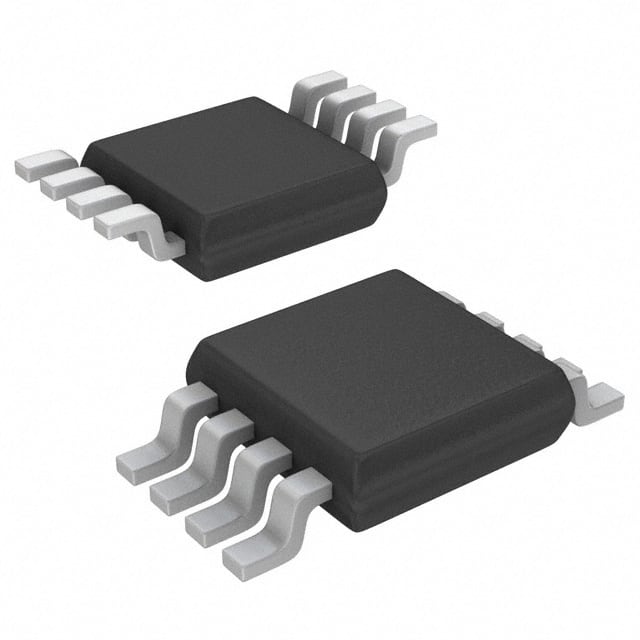Viz Specifikace pro podrobnosti o produktu.

X9315WMZT1
Product Overview
- Category: Integrated Circuit (IC)
- Use: Digital Potentiometer
- Characteristics: Non-volatile, 32 Taps, 100kΩ Resistance Range
- Package: SOT-23-6
- Essence: X9315WMZT1 is a digital potentiometer IC that provides a non-volatile solution for applications requiring adjustable resistance. It offers 32 taps with a resistance range of 100kΩ.
- Packaging/Quantity: The X9315WMZT1 is available in a SOT-23-6 package.
Specifications
- Resistance Range: 100kΩ
- Number of Taps: 32
- Interface Type: Serial
- Supply Voltage: 2.7V to 5.5V
- Operating Temperature Range: -40°C to +85°C
- Non-volatile Memory: Yes
- Wiper Current: 3mA (maximum)
Detailed Pin Configuration
The X9315WMZT1 has a total of six pins arranged as follows:
┌───┬───┐
│ 1 │ 6 │
│ │ │
│ │ │
│ │ │
│ │ │
│ 2 │ 5 │
└───┴───┘
Pin Description: 1. VCC: Supply Voltage 2. H: High Terminal of the Potentiometer 3. W: Wiper Terminal of the Potentiometer 4. B: Low Terminal of the Potentiometer 5. CS: Chip Select Input 6. GND: Ground
Functional Features
- Non-volatile memory allows the X9315WMZT1 to retain its settings even when power is removed.
- Serial interface enables easy control and adjustment of resistance.
- 32 taps provide fine-grained adjustment options.
- Wide operating temperature range makes it suitable for various environments.
Advantages and Disadvantages
Advantages: - Non-volatile memory ensures settings are retained during power cycles. - Serial interface simplifies control and integration into digital systems. - Fine-grained adjustment with 32 taps allows precise resistance tuning. - Wide operating temperature range expands application possibilities.
Disadvantages: - Limited resistance range of 100kΩ may not be suitable for all applications. - Higher wiper current compared to some alternative models.
Working Principles
The X9315WMZT1 utilizes a combination of resistive ladder network and electronic switches to adjust the resistance. The position of the wiper determines the effective resistance between the high and low terminals. The digital potentiometer communicates with an external microcontroller or digital circuit through the serial interface, allowing precise control over the wiper position and thus the resistance value.
Detailed Application Field Plans
The X9315WMZT1 finds applications in various fields where adjustable resistance is required. Some potential application areas include:
- Audio Equipment: Volume control circuits, equalizers, and tone control circuits.
- Industrial Control Systems: Calibration circuits, sensor signal conditioning, and feedback control systems.
- Test and Measurement Instruments: Programmable voltage dividers, signal generators, and calibration equipment.
- Communication Systems: Variable gain amplifiers, filters, and impedance matching circuits.
Detailed and Complete Alternative Models
- MCP401X: Microchip Technology offers a series of digital potentiometers with similar specifications and package options.
- AD840X: Analog Devices provides digital potentiometers with extended resistance ranges and additional features.
- MAX54X: Maxim Integrated offers digital potentiometers with low wiper resistance and high resolution.
These alternative models provide similar functionality to the X9315WMZT1 and can be considered based on specific application requirements.
Word count: 488
Seznam 10 běžných otázek a odpovědí souvisejících s aplikací X9315WMZT1 v technických řešeních
Sure! Here are 10 common questions and answers related to the application of X9315WMZT1 in technical solutions:
Q1: What is X9315WMZT1? A1: X9315WMZT1 is a digital potentiometer, specifically a non-volatile memory (NVM) version, which can be used to replace mechanical potentiometers in various applications.
Q2: What is the operating voltage range of X9315WMZT1? A2: The operating voltage range of X9315WMZT1 is typically between 2.7V and 5.5V.
Q3: Can X9315WMZT1 be used in both analog and digital circuits? A3: Yes, X9315WMZT1 can be used in both analog and digital circuits as it provides a digitally controlled variable resistor.
Q4: How many taps or steps does X9315WMZT1 have? A4: X9315WMZT1 has 32 taps or steps, allowing for precise adjustment of resistance.
Q5: Is X9315WMZT1 a single-channel or multi-channel device? A5: X9315WMZT1 is a single-channel device, meaning it can control the resistance of one circuit at a time.
Q6: Can X9315WMZT1 be used in audio applications? A6: Yes, X9315WMZT1 can be used in audio applications such as volume control or tone adjustment.
Q7: Does X9315WMZT1 have non-volatile memory? A7: Yes, X9315WMZT1 has non-volatile memory, which means it retains its settings even when power is removed.
Q8: What is the resolution of X9315WMZT1? A8: The resolution of X9315WMZT1 is 10 bits, allowing for precise adjustment in small increments.
Q9: Can X9315WMZT1 be controlled using a microcontroller? A9: Yes, X9315WMZT1 can be easily controlled using a microcontroller through its digital interface.
Q10: What are some typical applications of X9315WMZT1? A10: Some typical applications of X9315WMZT1 include audio equipment, instrumentation, industrial control systems, and programmable voltage references.
Please note that the answers provided here are general and may vary depending on specific datasheet specifications and application requirements.

